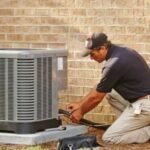Air conditioning systems are among the most important components of modern homes, keeping indoor spaces comfortable during hot months. However, frequent repairs and unexpected breakdowns can be costly and inconvenient. Homeowners are increasingly turning to smart thermostats as a practical solution that not only improves comfort but also reduces wear and tear on their air conditioners. By intelligently managing cooling cycles, offering real-time adjustments, and promoting more efficient energy habits, these devices help prevent unnecessary strain on equipment. We will explore how smart thermostats support efficiency and play a significant role in reducing the likelihood of AC repairs.
Ways Smart Thermostats Reduce AC Repairs
Optimized Temperature Regulation Reduces System Strain
A major cause of air conditioning repairs comes from overuse or misuse of the system. Traditional thermostats often rely on manual settings, which can result in frequent adjustments and inconsistent temperature control. This type of usage places stress on the compressor and other critical AC components, increasing the chances of breakdowns. Smart thermostats address this issue by learning the household’s patterns and automatically adjusting cooling levels to strike a balance between comfort and efficiency.
For example, if the system knows the house will be empty during the day, it will ease back cooling efforts and then restore them before residents return. This consistent and automated regulation minimizes unnecessary system cycles, thereby reducing strain and prolonging the lifespan of the AC. As a result, homeowners experience fewer repair calls and enjoy better system reliability over time. Companies like Arctic Air Systems, Inc. highlight how these innovations give households both comfort and peace of mind by protecting their cooling systems.
Energy Monitoring Encourages Preventive Care
Another advantage of smart thermostats is their ability to provide detailed reports on energy usage. Homeowners gain valuable insights into how often their AC system is running, how much energy it consumes, and when it experiences peak loads. These insights serve as early indicators of potential problems. For instance, if energy consumption suddenly increases without a corresponding change in household patterns, it may indicate clogged filters, refrigerant leaks, or other maintenance concerns.
By alerting homeowners to these irregularities, smart thermostats promote preventive action before small issues escalate into major repairs. Additionally, many devices connect with smartphone apps that provide real-time notifications, enabling homeowners to stay informed about system performance, regardless of their location. This proactive approach helps reduce costly breakdowns and encourages routine maintenance, thereby extending the unit’s lifespan.
Remote Access Prevents Overuse
Smart thermostats enable users to remotely control their AC systems through mobile devices. This feature is especially helpful for households where schedules often change unexpectedly. Without remote access, homeowners may leave the system running for hours while no one is home, unnecessarily increasing wear and energy use. With a smart thermostat, they can adjust the settings from anywhere, ensuring the AC only runs when needed. Preventing unnecessary overuse reduces long-term strain on motors, compressors, and other mechanical parts, lowering the likelihood of sudden failures. Over time, this convenience not only saves money on energy bills but also preserves the overall health of the air conditioning system, reducing the need for emergency repair services.
Integration with Maintenance Reminders
One overlooked feature of many smart thermostats is the ability to provide maintenance reminders. While homeowners often delay routine maintenance tasks, such as changing filters or scheduling tune-ups, these small tasks are crucial in preventing larger problems. Dirty filters restrict airflow, causing the system to overwork and risk damage to the blower motor. Similarly, skipping annual inspections can allow refrigerant issues or electrical problems to go unnoticed until they cause significant damage.
Smart thermostats help by sending reminders at the right time, prompting homeowners to complete these tasks before they become urgent. By encouraging timely maintenance, smart devices reduce the risk of costly breakdowns and ensure the system continues running smoothly. This feature transforms routine care from something easy to forget into a consistent habit that directly prevents AC repairs.
Adaptive Learning Adjusts for Seasonal Changes
Seasonal transitions can be challenging for air conditioning systems, particularly when weather patterns fluctuate. Constant adjustments to temperature settings in traditional systems can strain equipment, especially during sudden heatwaves. Smart thermostats solve this issue with adaptive learning capabilities that track climate conditions and user habits over time. These devices adjust cooling cycles in response to outdoor temperatures and household preferences, providing smoother and more consistent performance.
By preventing sudden or excessive strain during extreme weather, adaptive learning reduces the risk of system overloads that often lead to repairs. For instance, instead of forcing the system to run at maximum capacity on an unexpectedly hot day, the thermostat gradually adjusts temperatures to keep the home cool without overwhelming the AC. This intelligent management helps safeguard equipment and promotes long-term reliability.
Improved Airflow Management through Zoning
Some smart thermostats integrate with zoning systems, allowing homeowners to cool specific areas of the house rather than the entire property at once. Traditional systems often waste energy by cooling empty rooms, which increases wear and tear on the AC. With zoning, energy is directed only where it is needed, reducing overall system usage. By lowering the demand placed on the AC, smart thermostats with zoning capability reduce stress on equipment components, decreasing the likelihood of repairs. Furthermore, zoning prevents uneven cooling, which can cause residents to over-adjust the thermostat, leading to more frequent cycles. Over time, this precise control ensures a balanced workload for the air conditioning system, improving efficiency while protecting it from unnecessary strain.
Smart thermostats are more than just modern gadgets for convenience; they are practical tools that play a significant role in preserving the health of air conditioning systems. By regulating temperature efficiently, providing real-time energy monitoring, offering remote access, sending maintenance reminders, and adapting to seasonal conditions, these devices reduce unnecessary strain on AC units. Features like zoning and data-driven insights further enhance performance, creating a balanced workload that minimizes the risk of breakdowns. Investing in a smart thermostat helps homeowners save money on energy bills while reducing the frequency of costly repairs.















